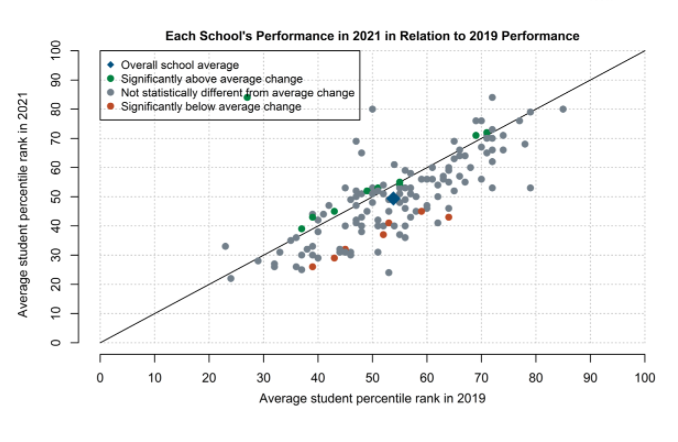by GARRY RAYNO, InDepthNH.org
CONCORD — Fewer students took the statewide assessment tests this spring and those who did on average performed below earlier levels for math and English, but were near historical levels for science.
Released Tuesday by the Department of Education, the assessment scores show New Hampshire students fell well short of past results for proficiency in math, less so in English and just slightly below in science.
Education Commissioner Frank Edelblut blames remote learning and the pandemic for the poorer results, but students in some school districts like Hanover and Bedford performed as well or even better than they did in the past, while students in large cities and property poor districts did not come close to past results with their historical levels.
“It is clear and understandable that trauma from the pandemic continues to impact schools, students and teachers,” said Edelblut. “Nationwide, assessment proficiency in both reading and math has slipped in the past five years, even pre-pandemic.”
He noted parents continue to have valid concerns about their children’s academic progress, and said measurable improvements are the goal and the state’s focus.
Overall 38 percent of students scored proficient or above in math for 2021, but 48 percent did in 2019; 52 percent scored proficient or above in reading in 2021, compared to 56 percent in 2019, and 37 percent were proficient or above in science, compared to 39 percent in 2019.
No assessment tests were given in the Spring of 2020 due to the pandemic.
“The impact to math scores was noticeably larger than for ELA (English Language Arts) scores. New Hampshire’s results in ELA are some of the smallest decreases we have seen nationally, which is good,” said Scott Marion, executive director of the National Center for the Improvement of Educational Assessment, a Dover-based technical consulting firm. “Similarly, in New Hampshire, the learning disruptions seem to be consistent across the different racial groups compared to where they started. Nationwide, however, the gap between high and low performing students tended to widen.”
But the gap between school districts in the state indicate what the Education Funding Commission emphasized in its 2020 report, that students from property rich communities perform better than those in property poor districts.
For example, districtwide Hanover students did better in two of three categories in tests this spring compared to two years ago for area proficiency and above, 83 percent in English, 79 percent in math and 83 percent in science falling just short in math.
Bedford students also performed close to their 2019 scores, at 78 percent, 70 percent and 58 percent, which was better in science than 2019.
However Newport had considerably less students reaching proficiency or above this spring with 20 percent, 10 percent and 24 percent, all well below their scores in 2019.
Pittsfield students scored 38 percent, 21 percent and 32 percent, with math and English below 2019 scores, but science above.
Portsmouth students were near their 2019 scores but were below in all three categories this spring with 73 percent, 61 percent and 44 percent.
Manchester students were considerably below their 2019 scores in 2021 in two categories, 27 percent for English and 14 percent for math, but science was 2 percent above 2019 at 17 percent.
Rochester students were significantly below their 2019 scores this spring at 35 percent, 28 percent and 34 percent.
The New Hampshire School Fair Funding Project said the state education funding system so dependent on local property taxes is an inequitable system that plays out in graduation rates and test scores.
“All New Hampshire children deserve the same chance at a quality public education and a school funding system that relies mainly on local property taxes only serves to create separate and unequal opportunity,” the organization said in a statement. “These inequities will be exacerbated in the coming years due to the legislature’s decision not to extend Fiscal Capacity Disparity Aid in the last budget, a program that previously sent additional state education aid to communities with particularly low property value. If we’re concerned about declining proficiency, we shouldn’t be reducing funds to school districts.”
The group noted that under the current state budget Newport will lose more than $700,000 in state education aid, Manchester will lose over $1.2 million, and Rochester will see a drop of more than $2.7 million.
The number of students taking the tests were also significantly lower this spring than two years ago, according to the report.
This year 73,406 New Hampshire students completed the assessment tests for math versus 91,050 in 2019.
For reading, participation numbers dropped from 90,785 students in 2019 to 72,880 this spring.
And science, which is measured in fewer grades, dropped from 37,720 in 2019 to 28,495 this spring.
“In general, we know that the students who learned remotely fared worse than those who learned in-person,” said Marion. “While everyone’s scores suffered nationwide, the test scores for those students who had in-person learning suffered less. This was generally the case in New Hampshire as well, especially in mathematics.”
Individual school information is available on the Department of Education’s website at:
Garry Rayno may be reached at garry.rayno@yahoo.com.





